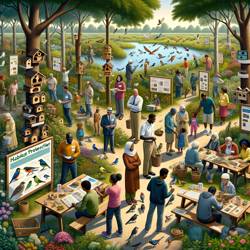The Importance of Bird Habitats
Birds, with their vibrant plumage and melodious songs, are an integral part of our natural world. However, their survival is intricately linked to the habitats they occupy. Understanding and protecting these habitats is crucial for maintaining biodiversity and ecological balance.
Understanding Bird Habitats

Bird habitats are the environments where birds live, feed, breed, and migrate. These habitats vary widely depending on the species' needs and geographical location. From dense forests to arid deserts, each habitat provides unique resources essential for different bird species. The importance of these habitats cannot be overstated as they support not only birds but also a myriad of other life forms.
Birds are often considered indicators of environmental health. A thriving bird population typically signifies a well-balanced ecosystem. Conversely, a decline in bird numbers can signal underlying environmental issues such as pollution or habitat destruction. Thus, understanding bird habitats helps us monitor and maintain the health of our ecosystems.
Types of Bird Habitats
Birds inhabit a wide range of environments across the globe. Forests, both tropical and temperate, host a diverse array of bird species such as woodpeckers and warblers. These birds rely on trees for nesting sites and food sources like insects and fruits.
Wetlands are another critical habitat type. They support species like herons and ducks that depend on water bodies for feeding and breeding. Wetlands act as natural water filters and flood controls, further highlighting their ecological importance.
Grasslands provide a home for ground-nesting birds like quails and sparrows. These open areas offer seeds and insects as primary food sources. Meanwhile, urban areas have become increasingly important as bird habitats due to urbanization; species like pigeons and sparrows have adapted remarkably well to city life.
| Habitat Type | Example Birds | Key Features |
|---|---|---|
| Forests | Woodpeckers, Warblers | Trees for nesting & food |
| Wetlands | Herons, Ducks | Water bodies for feeding/breeding |
| Grasslands | Quails, Sparrows | Open areas with seeds/insects |
| Urban Areas | Pigeons, Sparrows | Adapted to human environments |
The Role of Bird Habitats in Ecosystems
Bird habitats play an essential role in maintaining ecological balance. Birds contribute to ecosystems by pollinating plants, dispersing seeds, controlling pest populations, and serving as prey for other wildlife. For instance, hummingbirds are vital pollinators for many flowering plants.
In addition to their ecological roles, birds also have cultural significance across various societies. They inspire art, literature, and even spiritual beliefs in many cultures worldwide.
Furthermore, birdwatching has become a popular recreational activity that contributes significantly to local economies through tourism. According to the U.S Fish & Wildlife Service's 2016 National Survey of Fishing Hunting & Wildlife-Associated Recreation report over 45 million Americans engage in birdwatching annually contributing approximately $41 billion dollars to the economy!
Threats to Bird Habitats
Despite their importance bird habitats face numerous threats primarily due to human activities:
- Deforestation: Large-scale logging operations destroy forested areas reducing available nesting sites.
- Pollution: Contaminants from industrial activities affect water quality in wetlands impacting aquatic bird species.
- Urbanization: Expansion into natural areas leads to habitat fragmentation making it difficult for birds to find suitable living spaces.
- Climate Change: Altered weather patterns disrupt migration routes affecting seasonal breeding cycles.
These threats result not only in loss of biodiversity but also compromise ecosystem services provided by birds which ultimately affects human well-being too!
Conservation Efforts for Bird Habitats
Conservation efforts aim at preserving existing habitats while restoring degraded ones ensuring long-term survival prospects for avian populations globally:
1) Protected Areas: Establishing national parks reserves helps safeguard critical breeding grounds from development pressures. 2) Restoration Projects: Initiatives focused on reforestation wetland rehabilitation enhance habitat quality supporting diverse wildlife communities. 3) Legislation & Policies: Enforcing laws regulations aimed at reducing pollution curbing deforestation ensures sustainable resource management practices. 4) Community Engagement: Involving local communities fosters stewardship encouraging responsible land-use decisions benefiting both people nature alike!
Efforts like these have led successful recoveries certain endangered species demonstrating effectiveness collaborative conservation strategies worldwide!
Community Involvement in Habitat Protection

Local communities play an indispensable role in protecting bird habitats! Grassroots initiatives often spearheaded by passionate individuals groups drive meaningful change at ground level:
- Citizen science projects enable residents participate monitoring efforts collecting valuable data about local avian populations.
- Educational programs raise awareness about importance conserving natural spaces promoting sustainable lifestyle choices among younger generations.
- Volunteer opportunities allow community members actively engage restoration activities fostering sense ownership pride within neighborhoods!
By empowering communities take action collectively we can create lasting positive impacts safeguarding future generations enjoy beauty diversity offered our feathered friends!
Future Challenges for Bird Habitat Preservation
Looking ahead several challenges loom large over future preservation efforts necessitating proactive approaches address them effectively:
1) Balancing Development Conservation Needs - As global population continues grow demand land resources increases posing significant challenge balancing economic growth environmental sustainability goals simultaneously! 2) Adapting Climate Change Impacts - Developing adaptive management strategies mitigate adverse effects changing climate conditions remains critical priority ensure resilience avian populations moving forward! 3) Enhancing International Cooperation - Cross-border collaborations vital tackling transnational issues like migratory route disruptions illegal wildlife trade requiring coordinated responses multiple stakeholders involved achieve meaningful progress towards shared objectives!